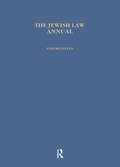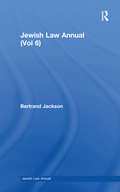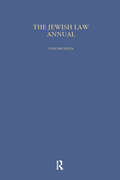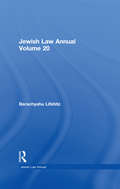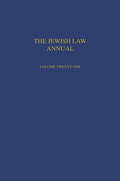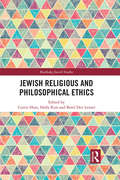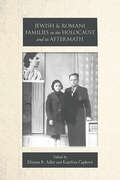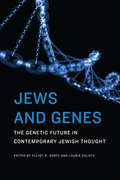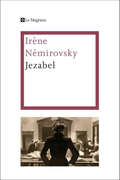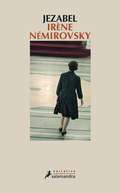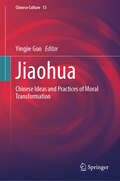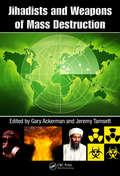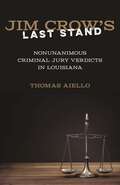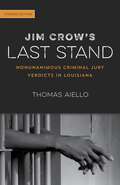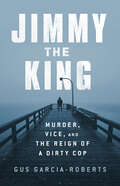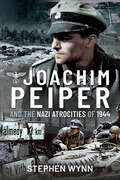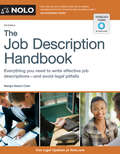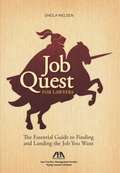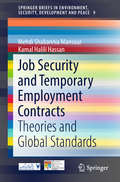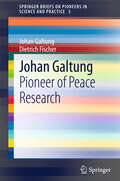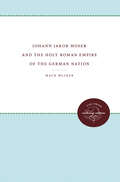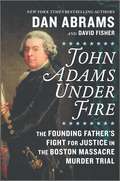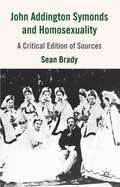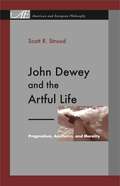- Table View
- List View
Jewish Law Annual (Jewish Law Annual #11)
by Bernard S. JacksonFirst published in 2004. This collection of papers is Volume eleven of the The Jewish Law Institute. Split onto two parts, it covers topics such as The Rabbinic Law on Entry and Seizure, the Problem of Priority in Civil Law, Analogical Argument in Early Jewish law amongst others. Part two entitled Chronicle, has examples of cases.
Jewish Law Annual (Jewish Law Annual #6)
by Bertrand JacksonFirst Published in 1987. Routledge is an imprint of Taylor & Francis, an informa company.
Jewish Law Annual (Jewish Law Annual #7)
by Bernard S JacksonFirst Published in 1988. The Annual is published under the auspices of The Institute of Jewish Law, Boston University School of Law, in conjunction with the Oxford Centre for Postgraduate Hebrew Studies and the International Association of Jewish Lawyers and Jurists. This volume concludes the symposium on the philosophy of Jewish law which started in Volume 6. It concludes with a response by the late Julius Stone to most of the preceding articles. This edition looks at natural law and Judaism, Halakhah and the Covenant; Jewish attitudes towards the taking of human life; mortality; and a study of Solomon Freehof.
Jewish Law Annual Volume 20 (Jewish Law Annual #20)
by Berachyahu LifshitzVolume 20 of The Jewish Law Annual features six detailed studies. The first three articles consider questions which fall under the rubric of halakhic methodology. The final three articles address substantive questions regarding privacy, cohabitation and medical triage. All three ‘methodological’ articles discuss creative interpretation of legal sources. Two (Cohen and Gilat) consider the positive and forward-thinking aspects of such halakhic creativity. The third (Radzyner) examines tendentious invocation of new halakhic arguments to advance an extraneous interest. Cohen explores positive creativity and surveys the innovative midrashic exegeses of R. Meir Simha Hakohen of Dvinsk, demonstrating his willingness to base rulings intended for implementation on such exegesis. Gilat examines exegetical creativity as to the laws of capital offenses. Midrashic argumentation enables the rabbinical authorities to set aside the literal sense of the harsh biblical laws, and implement more suitable penological policies. On the other hand, Radzyner’s article on tendentious innovation focuses on a situation where novel arguments were advanced in the context of a power struggle, namely, Israeli rabbinical court efforts to preserve jurisdiction. Two articles discuss contemporary dilemmas. Spira & Wainberg consider the hypothetical scenario of triage of an HIV vaccine, analyzing both the talmudic sources for resolving issues related to allocating scarce resources, and recent responsa. Warburg discusses the status of civil marriage and cohabitation vis-à-vis payment of spousal maintenance: can rabbinical courts order such payment? Schreiber’s article addresses the question of whether privacy is a core value in talmudic law: does it indeed uphold a ‘right to privacy,’ as recent scholars have claimed? The volume concludes with a review of Yuval Sinai’s Application of Jewish Law in the Israeli Courts (Hebrew).
Jewish Law Annual Volume 21 (Jewish Law Annual #21)
by Benjamin PoratVolume 21 of The Jewish Law Annual adds to the growing list of articles on Jewish law that have been published in volumes 1- 20 of this series, providing English-speaking readers with scholarly articles presenting jurisprudential, historical, textual and comparative analysis of issues in Jewish law.
Jewish Religious and Philosophical Ethics (Routledge Jewish Studies Series)
by Halla Kim Curtis Hutt Berel Dov LernerTwentieth century continental thinkers such as Bergson, Levinas and Jonas have brought fresh and renewed attentions to Jewish ethics, yet it still remains fairly low profile in the Anglophone academic world. This collection of critical essays brings together the work of established and up-and-coming scholars from Israel, the United States, and around the world on the topic of Jewish religious and philosophical ethics. The chapters are broken into three main sections – Rabbinics, Philosophy, and Contemporary Challenges. The authors address, using a variety of research strategies, the work of both major and lesser-known figures in historical Jewish religious and philosophical traditions. The book discusses a wide variety of topics related to Jewish ethics, including "ethics and the Mishnah," "Afro Jewish ethics," "Jewish historiographical ethics," as well as the conceptual/philosophical foundations of the law and virtues in the work of Martin Buber, Hermann Cohen, and Baruch Spinoza.The volume closes with four contributions on present-day frontiers in Jewish ethics. As the first book to focus on the nature, scope and ramifications of the Jewish ethics at work in religious and philosophical contexts, this book will be of great interest to anyone studying Jewish Studies, Philosophy and Religion.
Jewish and Romani Families in the Holocaust and its Aftermath
by Eliyana R. Adler Dalia Ofer Sarah Wobick-Segev Laura Hobson Faure Natalia Aleksiun Viktoria Banyai Robin Judd Anja Reuss Helena Sadílková Joachim Schlör Michal Unger Katerina Capková Volha BartashDiaries, testimonies and memoirs of the Holocaust often include at least as much on the family as on the individual. Victims of the Nazi regime experienced oppression and made decisions embedded within families. Even after the war, sole survivors often described their losses and rebuilt their lives with a distinct focus on family. Yet this perspective is lacking in academic analyses. In this work, scholars from the United States, Israel, and across Europe bring a variety of backgrounds and disciplines to their study of the Holocaust and its aftermath from the family perspective. Drawing on research from Belarus to Great Britain, and examining both Jewish and Romani families, they demonstrate the importance of recognizing how people continued to function within family units—broadly defined—throughout the war and afterward.
Jews and Genes: The Genetic Future in Contemporary Jewish Thought
by Rabbi Elliot N. Dorff Dr Laurie ZolothWell aware of Jews having once been the victims of Nazi eugenics policies, many Jews today have an ambivalent attitude toward new genetics and are understandably wary of genetic forms of identity and intervention. At the same time, the Jewish tradition is strongly committed to medical research designed to prevent or cure diseases. Jews and Genes explores this tension against the backdrop of various important developments in genetics and bioethics—new advances in stem cell research; genetic mapping, identity, testing, and intervention; and the role of religion and ethics in shaping public policy. Jews and Genes brings together leaders in their fields, from all walks of Judaism, to explore these most timely and intriguing topics—the intricacies of the genetic code and the wonders of life, along with cutting-edge science and the ethical issues it raises.
Jezabel
by Irène NémirovskyUn agut relat d'Irène Némirovsky, l'obra va ser acollida amb entusiasme no només a França: el New York Times la va considerar en el seu moment «la successora de Dostoievski» A la sala d’un tribunal se celebra el judici d'una dona. Gladys Eysenach ja no és jove, però ha estat molt bonica. Se l'acusa d'haver assassinat el seu amant, molt més jove que ella. Els testimonis van desfilant i l'advocat i el fiscal s'enfronten. Asseguda al recinte dels acusats, la protagonista sent fragments de la narració de la seva pròpia vida: la infantesa, l'exili, l'absència del pare, el matrimoni, les relacions tumultuoses amb la seva filla, l'edat i el declivi, fins a l'acte irreparable. Els membres del jurat i el públic remuguen, s'encenen. Però el culpable qui és? L'acusada? O el temps que fa bocins les il·lusions?
Jezabel
by Irène NémirovskyUn agudo relato de Irène Némirovsky, cuya obra fue acogida con entusiasmo no sólo en Francia: el New York Times la consideró en su día «la sucesora de Dostoievsky» Gladys Eysenach es acusada del asesinato de su presunto amante, un joven estudiante de apenas veinte años, y el caso levanta una enorme expectación en París. Madura y excepcionalmente bella para su edad, Gladys pertenece a esa alta sociedad apátrida que recorre Europa de fiesta en fiesta. Envidiada por las mujeres y deseada por los hombres, su vida se airea impúdicamente frente al juez: su infancia, el exilio, la ausencia del padre, su matrimonio, las difíciles relaciones con su hija, su fama de femme fatale, su fijación con la belleza y la juventud... El público, impaciente por conocer cada sórdido detalle, no comprende que la rica y envidiada Gladys, comprometida con un apuesto conde italiano, haya perdido la cabeza por un joven anodino, casi un niño. ¿Quién era la víctima: un amante despechado, un delincuente de poca monta o quizá el testigo incómodo de un secreto inconfesable? ¿Y por qué la acusada insiste en mostrarse culpable y exigir para sí misma un ejemplar castigo? La crítica ha dicho...«Un libro cristalino, feroz y prodigiosamente visionario en su tema central: el deseo de la eterna juventud.»La Repubblica «Un agudísimo retrato femenino, en el que Némirovsky plasma el desagrado que le inspiraba su propia madre, una mujer fría y narcisista.»Panorama «De ritmo veloz y gran dramatismo, nos permite vislumbrar un mundo de privilegios, riqueza y combate social darwinista en el periodo de entreguerras.»New Statesman
Jiaohua: Chinese Ideas and Practices of Moral Transformation (Chinese Culture #13)
by Yingjie GuoChapters &“Jiaohua through Humanistic Buddhism: Integrating Transcendence with Worldly Matters&” and "Jiaohua through Humanistic Buddhism: Integrating Transcendence with Worldly Matters" are available open access under a Creative Commons Attribution 4.0 International License via link.springer.com.
Jihad and Genocide (Studies In Genocide: Religion, History, And Human Rights Ser. #1)
by Richard L RubensteinA study of Islamic fundamentalism, its violent and deadly history, and the questions it raises today. This book examines the relationship between jihad and genocide, past and present. Richard L. Rubenstein takes a close look at the violent interpretations of jihad and how they have played out in the past hundred years, from the Armenian genocide through current threats to Israel. Rubenstein&’s unflinching study of the potential for fundamentalist jihad to initiate targeted violence raises pressing questions in a time when questions of religious co-existence, particularly in the Middle East, are discussed urgently each day. Praise for Jihad and Genocide&“Provocative, important reading for all interested in Arab-Israeli peace and religious coexistence worldwide. Highly recommended.&” —Choice Reviews&“Rubenstein&’s analysis stands the test of time. Thus, attention must be paid to Rubenstein's new work, Jihad and Genocide, which offers a searing analysis of Islamic thought and bleak predictions of its impact. Even those of us who do not share his pessimism, his sense of the inevitability of the path to genocide and war, or his predilection for the political right, must confront the issues he raises.&” —Foreword Reviews
Jihadists and Weapons of Mass Destruction
by Gary Ackerman Jeremy TamsettExplores the Nexus Formed When Malevolent Actors Access Malignant MeansWritten for professionals, academics, and policymakers working at the forefront of counterterrorism efforts, Jihadists and Weapons of Mass Destruction is an authoritative and comprehensive work addressing the threat of weapons of mass destruction (WMD) in the hands of jihadists,
Jim Crow's Last Stand: Nonunanimous Criminal Jury Verdicts in Louisiana
by Thomas AielloThe last remnant of the racist Redeemer agenda in the Louisiana's legal system, the nonunanimous jury-verdict law permits juries to convict criminal defendants with only ten out of twelve votes. A legal oddity among southern states, the ordinance has survived multiple challenges since its ratification in 1880. Despite the law's long history, few are aware of its existence, its original purpose, or its modern consequences. At a time when Louisiana's penal system has fallen under national scrutiny, Jim Crow's Last Stand presents a timely, penetrating, and concise look at the history of this law's origins and its troubling legacy. The nonunanimous jury-verdict law originally allowed a guilty verdict with only nine juror votes, funneling many of those convicted into the state's burgeoning convict lease system. Yet the law remained on the books well after convict leasing ended. Historian Thomas Aiello describes the origins of the statute in Bourbon Louisiana-a period when white Democrats sought to redeem their state after Reconstruction-its survival through the civil rights era of the 1950s and 1960s, and the Supreme Court's decision in Johnson v. Louisiana (1972), which narrowly validated the state's criminal conviction policy. Spanning over a hundred years of Louisiana law and history, Jim Crow's Last Stand investigates the ways in which legal policies and patterns of incarceration contribute to a new form of racial inequality.
Jim Crow’s Last Stand: Nonunanimous Criminal Jury Verdicts in Louisiana
by Thomas AielloA remnant of the racist post-Reconstruction Redeemer sociopolitical agenda, Louisiana’s nonunanimous jury-verdict law permitted juries to convict criminal defendants with only nine, and later ten, out of twelve votes: a legal oddity. On the surface, it was meant to speed convictions. In practice, the law funneled many convicts—especially African Americans—into Louisiana’s burgeoning convict lease system. Although it faced multiple legal challenges through the years, the law endured well after convict leasing had ended. Few were aware of its existence, let alone its original purpose. In fact, the original publication of Jim Crow’s Last Stand was one of the first attempts to call attention to the historical injustice caused by this law. This updated edition of Jim Crow’s Last Stand unpacks the origins of the statute in Bourbon Louisiana, traces its survival through the civil rights era, and ends with the successful effort to overturn the nonunanimous jury practice, a policy that officially went into effect on January 1, 2019.
Jimmy the King: Murder, Vice, and the Reign of a Dirty Cop
by Gus Garcia-RobertsAn incredible four-decade account of murder, power, and corruption in one of the country&’s largest police departments In 1979, the gruesome slaying of a thirteen-year-old boy riveted the suburbs of Suffolk County, New York. As the county hustled to bring the case to a dubious resolution, a wayward local teenager emerged with a convenient story to tell. For his cooperation, James Burke was rewarded with a job as a cop. Thus began Burke&’s unlikely ascent to the top of one of the country&’s largest law enforcement jurisdictions. He and a crew of likeminded allies utilized vengeance, gangster tactics, and political leverage to become the most powerful and feared figures in their suburban empire. In his quest to maintain that power, Burke botched -- intentionally or not -- dire investigations like that of the famed Gilgo Beach serial killings and the county's MS-13 gang scourge. Until a pilfered bag of sex toys brought it all crashing down.Jimmy the King is the story of the rise, reign, and paranoiac fall of a corrupt cop and his regime—a crime family with badges and guaranteed pensions. Novelistic in detail and piercing in its political insight, this book will leave you questioning who modern policing serves, who it protects, and who it preys upon and abandons.
Joachim Peiper and the Nazi Atrocities of 1944
by Stephen WynnJoachim Peiper held the rank of Obersturmbannführer in Nazi Germany’s fanatical Schutzstaffel, more commonly referred to as the SS. He spent the first two years of the war as an adjutant to the Reichsführer of the Schutzstaffel, and leading member of the Nazi Party, Heinrich Himmler, where he would have witnessed at first hand the construction and implementation of numerous SS policies, many of which would have been in relation to ethnic cleansing and the Holocaust. In October 1941, having yearned for a chance at combat, he changed roles and became a commander in the Waffen-SS, although he still remained in regular contact with Himmler. As a member of the 1st SS Panzer Division Leibstandarte, he saw service in the Soviet Union, Italy and Belgium. On 19 September 1943, he and his men were responsible for the murder of twenty-four Italian civilians at the village of Boves. On 17 December 1944, men under his command were responsible for what became known as the Malmedy massacre, involving the murder of eighty-four unarmed American prisoners of war. Following this, between 17 and 20 December, Peiper and his men were involved in the murder of a number of other American soldiers, as well as Belgian civilians. Peiper was never charged with the atrocities at Boves, but in 1946 he faced an American military tribunal for the Malmedy masssacre. Although found guilty and sentenced to death, his sentence was reduced to life imprisonment but he was eventually released in 1956. In 1972, Peiper moved to the French village of Troves in north east France. On 14 July 1976, his home was attacked and set on fire. Overcome by smoke, he died in the flames.
Job Description Handbook, The
by Margie Mader-ClarkEverything you need to define the job, step by step Every job has a description -- and if you craft it carefully, you can use a job description for effective hiring, new employee orientation, evaluating performances, discipline and plan for future growth. But if it's poorly written (or not written at all), your company can face all sorts of problems, from low employee morale to legal troubles. To meet your company's changing needs, The Job Description Handbook, an all-in-one resource, can help you create HR documents that provide the details of every job's duties, requirements, qualifications -- and much more. This book, written in Nolo's signature plain-English style, will help you: -create a good job description -hire qualified employees -evaluate an employee's job performance -plan for your company's future needs -avoid legal traps -troubleshoot a description The book also provides checklists, worksheets, resources, sample language and step-by-step instructions that you can use to create job descriptions that will work in the real world.
Job Quest for Lawyers: The Essential Guide to Finding and Landing the Job You Want
by Sheila NielsenThis book provides step-by-step guidance that finally makes networking inspiring instead of a chore. The "quest" motif applies to each stage of the job search. The book demystifies networking by including illustrations from the author's own experiences and from the stories of her clients that provide examples of the real world do's and don'ts of how to conduct a productive job search.
Job Security and Temporary Employment Contracts: Theories and Global Standards (SpringerBriefs in Environment, Security, Development and Peace #9)
by Mehdi Shabannia Mansour Kamal Halili HassanThis book discusses the need of a legal protection at national and global levels to address the use of temporary employment contracts by employers. Chapter 1 reviews some theories of job security, showing how job security issues should be regulated in labour laws to protect workers and also how temporary contracts affect job security. Chapter 2 examines legal protection of job security in temporary contract in international contexts where it examines the concept and need for job security and job protection especially for temporary contracts based on three United Nations’ instruments, namely, the Universal Declaration of Human Rights (UDHR), International Covenant on Civil and Political Rights (ICCPR), and International Covenant on Economic, Social and Cultural Rights (ICESCR). Chapter 3 studies the ILO standards in relation to job security and temporary contracts as well as those covered by the Philadelphia Declaration and other conventions and recommendations. Chapter 4 discusses Islamic jurisprudence on jobs and job security. The main aims of this chapter is to provide the framework for protecting workers as a means to enhance job security in the world especially in Islam. It discusses Islamic jurisprudence concerning work and job conditions. The Islamic precept is based on the Qur’an and Hadith and these sources are used to explain the concept of jobs in Islam. In addition, this chapter also examines the Cairo Declaration on Human Rights in Islam (CDHRI).
Johan Galtung
by Dietrich Fischer Johan GaltungThis is the first ever anthology of key articles by Johan Galtung, widely regarded as the founder of the academic discipline of peace studies. It covers such concepts as direct, structural and cultural violence; theories of conflict, development, civilization and peace; peaceful conflict transformation; peace education; mediation; reconciliation; a life-sustaining economy; macro-history; deep culture and deep structure; and social science methodology. Galtung has contributed original research, concepts and theories to more than 20 social science disciplines, including sociology, international relations and future studies, and has also applied his new insights in practice. The book is a valuable resource for researchers and practitioners, and can serve as a supplemental textbook for graduate and upper undergraduate courses in peace studies and related fields.
Johann Jakob Moser and the Holy Roman Empire of the German Nation
by Mack WalkerAs the most learned and eminent public lawyer in Germany, a busy administrator, and a prolific writer, Moser (1701-85) lived and breathed the political order. His correspondence, memoranda, and manuscript autobiography reflect the intricate day-to-day operations of the empire, and his fascinating life is a microcosm of the life and style of the empire itself. The biography provided a comprehensive picture of the empire between the Thirty Years War and the revolutionary era.Originally published 1981.A UNC Press Enduring Edition -- UNC Press Enduring Editions use the latest in digital technology to make available again books from our distinguished backlist that were previously out of print. These editions are published unaltered from the original, and are presented in affordable paperback formats, bringing readers both historical and cultural value.
John Adams Under Fire: The Founding Father's Fight for Justice in the Boston Massacre Murder Trial
by David Fisher Dan AbramsThe New York Times bestselling author of Lincoln’s Last Trial and host of LivePD Dan Abrams and David Fisher tell the story of a trial that would change history. <P><P>History remembers John Adams as a Founding Father and our country’s second president. But in the tense years before the American Revolution, he was still just a lawyer, fighting for justice in one of the most explosive murder trials of the era.On the night of March 5, 1770, shots were fired by British soldiers on the streets of Boston, killing five civilians. <P><P>The Boston Massacre has often been called the first shots of the American Revolution. As John Adams would later remember, “On that night the formation of American independence was born.” Yet when the British soldiers faced trial, the young lawyer Adams was determined that they receive a fair one. He volunteered to represent them, keeping the peace in a powder keg of a colony, and in the process created some of the foundations of what would become United States law. <P><P>In this book, New York Times bestselling authors Dan Abrams and David Fisher draw on the trial transcript, using Adams’s own words to transport readers to colonial Boston, a city roiling with rebellion, where British military forces and American colonists lived side by side, waiting for the spark that would start a war. <P><P><b>A New York Times Bestseller</b>
John Addington Symonds (1840–1893) and Homosexuality
by Sean BradyIn John Addington Symonds (1840 1893) and Homosexuality: A Critical Edition of Sources, Sean Brady brings together for the first time the correspondence between John Addington Symonds and Havelock Ellis on the project of Sexual Inversion. Ellis'Sexual Inversion became eventually his totemic Studies in the Psychology of Sex. But in many respects, the project Sexual Inversion was Symonds' brainchild. Ellis and Symonds never actually met, so the correspondence represents their completecommunication on the subject. Many of the letters in this critical source edition are published here for the first time, and the correspondence in its entirely has never been published together. This critical source edition also publishes Symonds' original privately printed essays, 'A Problem in Greek Ethics', and 'A Problem in Modern Ethics'. Sean Brady's critical introduction provides a new and interdisciplinary analysis of the significance of these texts, the correspondence, and of Symonds' place in the history of ideas and of gender and sexuality. This volume is an indispensable reference for a wide range of scholars working across multidisciplinary fields of inquiry that focus on British and continental histories of medicine and sexuality, gender history and studies of nineteenth-century culture, and introduces the new reader to Symonds' life and ideas on homosexuality. "
John Dewey and the Artful Life: Pragmatism, Aesthetics, and Morality (American and European Philosophy #7)
by Scott R. StroudAesthetic experience has had a long and contentious history in the Western intellectual tradition. Following Kant and Hegel, a human’s interaction with nature or art frequently has been conceptualized as separate from issues of practical activity or moral value. This book examines how art can be seen as a way of moral cultivation. Scott Stroud uses the thought of the American pragmatist John Dewey to argue that art and the aesthetic have a close connection to morality. Dewey gives us a way to reconceptualize our ideas of ends, means, and experience so as to locate the moral value of aesthetic experience in the experience of absorption itself, as well as in the experience of reflective attention evoked by an art object.
